Showing Spotlights 1689 - 1696 of 2780 in category All (newest first):
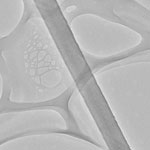 Nanowires - particularly those of silicon - promise great potentials for high-efficiency, low-cost solar energy conversion. This promise has not yet been met by experimental evidence, raising fundamental questions whether silicon nanowires are intrinsically disadvantaged and whether the photovoltaic research community should continue working on this material. Despite intense efforts, the performance of silicon nanowire-based solar cells remains significantly lower than what has been achieved for bulk silicon or micrometer-scale wires. The gap between the predicted performance and the inability to deliver raises an important question with regard to the origin of this problem. New research shows that the poor performance is not a result of the nanowire morphology, but is intrinsic to the growth chemistry.
Nanowires - particularly those of silicon - promise great potentials for high-efficiency, low-cost solar energy conversion. This promise has not yet been met by experimental evidence, raising fundamental questions whether silicon nanowires are intrinsically disadvantaged and whether the photovoltaic research community should continue working on this material. Despite intense efforts, the performance of silicon nanowire-based solar cells remains significantly lower than what has been achieved for bulk silicon or micrometer-scale wires. The gap between the predicted performance and the inability to deliver raises an important question with regard to the origin of this problem. New research shows that the poor performance is not a result of the nanowire morphology, but is intrinsic to the growth chemistry.
Mar 9th, 2011
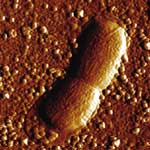 One of the main basic bacterial survival strategies is the colonization of a surface and the consequent growth as biofilm community, which is embedded in a gel-like polysaccharide matrix. In spite of its swimming/planktonic counterpart, such sessile adherent bacterial population represents an excellent life-support system. A biofilm like bacteria community is in fact highly resistant to almost any classical bactericidal and bacteriostatic tools, ranging from broad-spectrum antibiotics to UV-rays, disinfectant, heat, and so on. Thus, the design of biomaterials with active antibacterial and self-cleaning properties represents a good opportunity for solving the biofilm associated infections. One of the main goal is avoiding one of the first necessary steps required for the biofilm growth, namely the bacterial adhesion onto the target surface.
One of the main basic bacterial survival strategies is the colonization of a surface and the consequent growth as biofilm community, which is embedded in a gel-like polysaccharide matrix. In spite of its swimming/planktonic counterpart, such sessile adherent bacterial population represents an excellent life-support system. A biofilm like bacteria community is in fact highly resistant to almost any classical bactericidal and bacteriostatic tools, ranging from broad-spectrum antibiotics to UV-rays, disinfectant, heat, and so on. Thus, the design of biomaterials with active antibacterial and self-cleaning properties represents a good opportunity for solving the biofilm associated infections. One of the main goal is avoiding one of the first necessary steps required for the biofilm growth, namely the bacterial adhesion onto the target surface.
Mar 8th, 2011
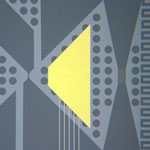 Currently, the most common methods for sizing nanoparticles extract data from bulk measurements. These techniques are inherently averaging and so are unable to effectively resolve mixtures of different-sized particles. While individual nanoparticles can be sized using electron microscopy, this approach is time-consuming and of little utility in assembling significant population statistics. Researchers have now developed a microfluidic device for the all-electronic analysis of complex suspensions of nanoparticles in fluid. This device is capable of detecting and sizing individual and unlabeled particles as small as a few tens of nanometers in diameter at rates estimated to exceed 100,000 particles per second.
Currently, the most common methods for sizing nanoparticles extract data from bulk measurements. These techniques are inherently averaging and so are unable to effectively resolve mixtures of different-sized particles. While individual nanoparticles can be sized using electron microscopy, this approach is time-consuming and of little utility in assembling significant population statistics. Researchers have now developed a microfluidic device for the all-electronic analysis of complex suspensions of nanoparticles in fluid. This device is capable of detecting and sizing individual and unlabeled particles as small as a few tens of nanometers in diameter at rates estimated to exceed 100,000 particles per second.
Mar 7th, 2011
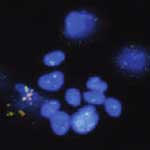 Multifunctional nanomaterials have become widely researched in nanomedicine with the goal of developing highly accurate probes for detecting and isolating cancer cells. Of particular interest here are magnetic nanoparticles, which offer the capability of cell isolation from original or enriched samples without the use of centrifugation or filtration. In particular, the combination of fluorescent quantum dots and magnetic nanoparticles into single nanospheres to obtain fluorescent-magnetic bifunctional nanospheres has created the potential for broader applications in biomedicine and in clinical diagnosis. In new work, researchers have now expanded this technique to multiplexed assays. They demonstrated the ability to detect and collect multiple types of cancer cells, such as leukemia cells and prostate cancer cells, from mixed samples within 25 minutes by using a magnet and an ordinary fluorescence microscope.
Multifunctional nanomaterials have become widely researched in nanomedicine with the goal of developing highly accurate probes for detecting and isolating cancer cells. Of particular interest here are magnetic nanoparticles, which offer the capability of cell isolation from original or enriched samples without the use of centrifugation or filtration. In particular, the combination of fluorescent quantum dots and magnetic nanoparticles into single nanospheres to obtain fluorescent-magnetic bifunctional nanospheres has created the potential for broader applications in biomedicine and in clinical diagnosis. In new work, researchers have now expanded this technique to multiplexed assays. They demonstrated the ability to detect and collect multiple types of cancer cells, such as leukemia cells and prostate cancer cells, from mixed samples within 25 minutes by using a magnet and an ordinary fluorescence microscope.
Mar 4th, 2011
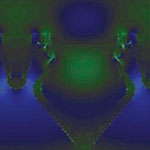 No matter how precise nanosensors and -probes become, bridging the huge gap between nanoscale dimensions and macroscale structures (e.g., wafer size) has been a tremendous challenge for researchers. Researchers in the U.S. have demonstrated a generalized hybrid nanofabrication concept that combines both top-down (deep-UV lithography) and bottom-up (controlled lateral epitaxial growth and atomic layer deposition) fabrication techniques. This unique methodology allows the development of reproducible nanostructured platforms that contain controlled sub-10 nm gaps between plasmonic nanostructures over an entire wafer, i.e. a 6-12 inch area. This approach opens new horizons to more widespread applications in chemical sensing and biomedical diagnostics.
No matter how precise nanosensors and -probes become, bridging the huge gap between nanoscale dimensions and macroscale structures (e.g., wafer size) has been a tremendous challenge for researchers. Researchers in the U.S. have demonstrated a generalized hybrid nanofabrication concept that combines both top-down (deep-UV lithography) and bottom-up (controlled lateral epitaxial growth and atomic layer deposition) fabrication techniques. This unique methodology allows the development of reproducible nanostructured platforms that contain controlled sub-10 nm gaps between plasmonic nanostructures over an entire wafer, i.e. a 6-12 inch area. This approach opens new horizons to more widespread applications in chemical sensing and biomedical diagnostics.
Mar 2nd, 2011
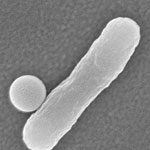 Bacterial propulsion systems are intriguing for nanotechnology researchers because nature has already solved most of the problems that they are still struggling with in designing molecular motors and other self-sustained nanoscale actuating systems. Indeed, it has turned out to be very challenging to even move sub-micron scale structures in well directed paths, especially under biologically friendly conditions. In previous work, researchers have already shown how large numbers of bacteria can propel larger sub-mm scale structures. And in a 2005 paper, researchers demonstrated a method of using the power generated by biological motors to transport microscale loads while leaving these motors in intact cells. Scientists at Johns Hopkins University have now demonstrated a strategy to autonomously move nanostructures in well defined paths by enabling individual bacteria-cargo conjugates. They showed how approximately 500 nm-sized structures deposited on substrates can be attached to individual bacteria and when released, the bacteria stay motile and ferry this cargo.
Bacterial propulsion systems are intriguing for nanotechnology researchers because nature has already solved most of the problems that they are still struggling with in designing molecular motors and other self-sustained nanoscale actuating systems. Indeed, it has turned out to be very challenging to even move sub-micron scale structures in well directed paths, especially under biologically friendly conditions. In previous work, researchers have already shown how large numbers of bacteria can propel larger sub-mm scale structures. And in a 2005 paper, researchers demonstrated a method of using the power generated by biological motors to transport microscale loads while leaving these motors in intact cells. Scientists at Johns Hopkins University have now demonstrated a strategy to autonomously move nanostructures in well defined paths by enabling individual bacteria-cargo conjugates. They showed how approximately 500 nm-sized structures deposited on substrates can be attached to individual bacteria and when released, the bacteria stay motile and ferry this cargo.
Mar 1st, 2011
 Quantum dots, because they are both photoluminescent and electroluminescent and have unique physical properties, will be at the core of next-generation displays. Compared to organic luminescent materials used in organic light emitting diodes (OLEDs), QD-based materials have purer colors, longer lifetime, lower manufacturing cost, and lower power consumption. Another key advantage is that, because QDs can be deposited on virtually any substrate, you can expect printable and flexible displays of all sizes. To date, the integration of QDs into a full-color LED structure has not been possible due to the difficulty in patterning individual red-green-blue (RGB) QDs onto the pixelated display panel. Now, a Samsung team has demonstrated a novel transfer printing approach which enables fine patterning of high-quality QD films for large-area (4-inch diagonal), full-color displays mounted on glass as well as on flexible plastic substrates.
Quantum dots, because they are both photoluminescent and electroluminescent and have unique physical properties, will be at the core of next-generation displays. Compared to organic luminescent materials used in organic light emitting diodes (OLEDs), QD-based materials have purer colors, longer lifetime, lower manufacturing cost, and lower power consumption. Another key advantage is that, because QDs can be deposited on virtually any substrate, you can expect printable and flexible displays of all sizes. To date, the integration of QDs into a full-color LED structure has not been possible due to the difficulty in patterning individual red-green-blue (RGB) QDs onto the pixelated display panel. Now, a Samsung team has demonstrated a novel transfer printing approach which enables fine patterning of high-quality QD films for large-area (4-inch diagonal), full-color displays mounted on glass as well as on flexible plastic substrates.
Feb 28th, 2011
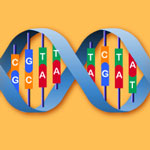 A Single Nucleotide Polymorphism (SNP) is a single nucleotide replacement in a DNA sequence - occurring when a single nucleotide (A, T, C, or G) in the genome differs - which can result in different reaction by people to pathogens and medicines. Detection of these SNPs is becoming increasingly important with the move towards more personalized healthcare. Researchers are therefore working hard in developing biomedical lab-on-chip sensors that allow the fast detection of SNPs in DNA using only very small samples of a patient's blood. Already, nanoscale detection techniques such as synthetic nanochannels are being used for DNA detection by specific DNA hybridization with molecular probes immobilized on the nanochannel walls. However, the preparation of these sensors is not easy and specific functionalization at the wall surface remains a critical issues. Researchers have now introduced a new concept of DNA-based molecular recognition agents which allows detecting SNPs with very high precision and efficiency.
A Single Nucleotide Polymorphism (SNP) is a single nucleotide replacement in a DNA sequence - occurring when a single nucleotide (A, T, C, or G) in the genome differs - which can result in different reaction by people to pathogens and medicines. Detection of these SNPs is becoming increasingly important with the move towards more personalized healthcare. Researchers are therefore working hard in developing biomedical lab-on-chip sensors that allow the fast detection of SNPs in DNA using only very small samples of a patient's blood. Already, nanoscale detection techniques such as synthetic nanochannels are being used for DNA detection by specific DNA hybridization with molecular probes immobilized on the nanochannel walls. However, the preparation of these sensors is not easy and specific functionalization at the wall surface remains a critical issues. Researchers have now introduced a new concept of DNA-based molecular recognition agents which allows detecting SNPs with very high precision and efficiency.
Feb 25th, 2011
 Nanowires - particularly those of silicon - promise great potentials for high-efficiency, low-cost solar energy conversion. This promise has not yet been met by experimental evidence, raising fundamental questions whether silicon nanowires are intrinsically disadvantaged and whether the photovoltaic research community should continue working on this material. Despite intense efforts, the performance of silicon nanowire-based solar cells remains significantly lower than what has been achieved for bulk silicon or micrometer-scale wires. The gap between the predicted performance and the inability to deliver raises an important question with regard to the origin of this problem. New research shows that the poor performance is not a result of the nanowire morphology, but is intrinsic to the growth chemistry.
Nanowires - particularly those of silicon - promise great potentials for high-efficiency, low-cost solar energy conversion. This promise has not yet been met by experimental evidence, raising fundamental questions whether silicon nanowires are intrinsically disadvantaged and whether the photovoltaic research community should continue working on this material. Despite intense efforts, the performance of silicon nanowire-based solar cells remains significantly lower than what has been achieved for bulk silicon or micrometer-scale wires. The gap between the predicted performance and the inability to deliver raises an important question with regard to the origin of this problem. New research shows that the poor performance is not a result of the nanowire morphology, but is intrinsic to the growth chemistry.
 Subscribe to our Nanotechnology Spotlight feed
Subscribe to our Nanotechnology Spotlight feed





